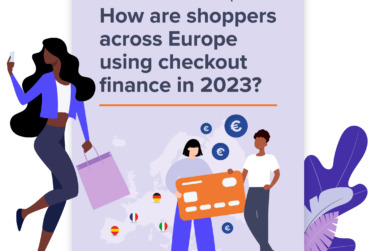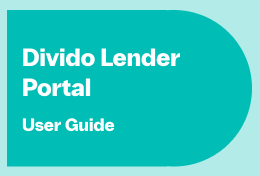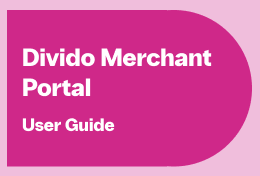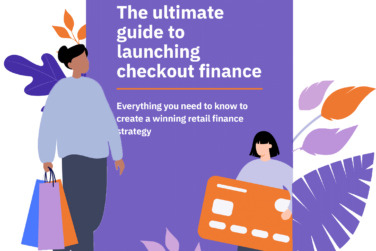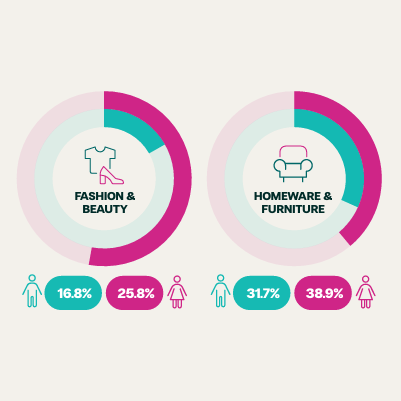What is retail finance? (And where does BNPL fit in?)

Retail finance has had a pretty spectacular couple of years. After a boost in digital spend thanks to the covid pandemic, the sector is now worth a whopping €302.9 billion and growing at a rate of 25.5% per year. But what is retail finance? What exactly do retail financing companies offer? And how can it benefit your business and customers?
In this article, we take a look at the different retail finance products retail financing companies offer so you can decide which is right for your business.
What is retail finance?
Retail finance is a form of finance offered by lenders to retailers. It enables merchants and retailers to offer credit products at their checkout and points of sale. Consumers can spread the cost of a transaction over a period of time, normally at little to no cost.
Where the customer has the option to pay with cash or card, they may also be offered the chance to split the cost over instalments, sometimes with a deferred payment period.
Retail finance is therefore sometimes referred to as point-of-sale (POS) finance, checkout finance, deferred payments, post-pay, and instalments as a service. These categories cover a broad range of credit products.
The most well known iteration of retail finance is Buy Now, Pay Later (BNPL). The whole retail finance sector often falls under the umbrella of Buy Now, Pay Later, though strictly speaking this is incorrect. In reality, BNPL is just one type of retail finance.
How does the retail finance business model work?
Traditional lending charges consumers interest on their borrowing. But point-of-sale finance is usually free to use, so long as the loan amount is not too high and the repayment period is short.
But if the lenders aren’t receiving interest from the consumer, how are they making money?
The answer is that the merchant pays the lender a percentage of the value of the transaction, usually around 2–8%. Merchants may also pay an additional monthly subscription fee, and an installation fee (paid at the time they set up the retail finance programme).
What are the different types of retail finance?
Retail finance encompasses a range of regulated and unregulated credit products. There are around 150 providers globally, each offering retail finance in a slightly different way.
However, despite the many flavours of retail finance, providers can be split into two main categories:
Traditional retail finance
Traditional retail finance providers provide both the lending platform and the loan. These types of providers slap their own branding onto the merchant’s checkout, then lend to consumers from their own balance sheets. They often finance these loans by borrowing from central banks.
Whitelabel retail finance
Whitelabel retail finance providers give merchants control over their customer journey by enabling finance under the merchant’s branding. A whitelabel provider connects consumers to one or multiple third-party lenders, usually Tier One banks. Divido’s platform is one example of a whitelabel platform.
Retail finance products differ in their offering but generally share the following characteristics:
- Retail finance appears as a payment method at the merchant’s checkout via an API (online) or using a merchant portal (in-store)
- The consumer pays an initial deposit
- The rest of the cost is split into monthly instalments to be paid over several weeks, months or years
- The consumer receives their goods right away
- There are typically no fees to pay, though some providers do charge interest and late fees
What retail finance options are available to retailers?
Buy Now, Pay Later (BNPL)
The best-known form of retail finance is Buy Now, Pay Later (BNPL). BNPL is a form of interest-free credit that lets consumers purchase an item immediately (sometimes after an initial deposit), then pay it off over a short period. Instalments are repaid on a weekly or monthly basis. There are usually no additional fees to pay, unless a payment is missed.
Consumers can make transactions up to £250 after a soft credit check, with an upper credit limit of around £2,000–4,000, depending on the provider.
Buy Now, Pay Later is most commonly found at online checkouts but is increasingly found at physical checkouts too. Physical and virtual BNPL cards are also becoming commonplace – these allow customers to spend at multiple locations up to an agreed credit limit, while only paying back a single loan.
Short-term Interest-free Credit (STIFC)
Short-term Interest-free Credit (STIFC) allows consumers to spread the cost of a purchase over a period up to 36 months after an initial deposit. Many providers offer a deferred payment period after the initial purchase, which can extend up to six months. Repayments are then taken on a weekly or monthly basis.
STIFC usually requires a hard credit check, which is why the finance tends to be provided by regulated financial institutions. It is mostly used to finance larger-value purchases, ranging from £250 up to £25,000. Home furnishings, sports and leisure, DIY and travel companies are some of the many types of businesses that offer STIFC.
STIFC is commonly found in stores at the checkout, though it is increasingly appearing at online checkouts too. The lines between BNPL and STIFC are therefore becoming somewhat blurred.
Interest-bearing Credit
Interest-bearing retail finance functions in the same way as interest-free retail finance products. It is found at the checkout, allows consumers to spread the cost of a purchase over a short period, and offers a deferred payment period. Often, lenders will also offer interest-free credit products.
Interest-bearing retail finance differs, however, in that lenders charge interest on the loan. This is often due to the lender’s appetite for risk.
A high price, longer repayment period, or lower credit score are some of the reasons a lender may charge interest. This helps them to compensate for the ‘riskiness’ of the loan. Interest-bearing retail finance is likely to grow in volume in the coming months as lending at 0% becomes less viable for lenders.
Pay in 30
This deferred credit option does what it says on the tin. It delays payment for 30 days with no interest or fees.
Which retail finance product is best?
Whether Buy Now, Pay Later is better than Short-term Interest-free Credit, Interest-bearing Credit or a Pay in 30 style product will depend on your business.
If you sell low value products with an average order value of £500 or less, then Buy Now, Pay Later is probably the best option for you. Consumers looking to spread the cost in three or four instalments can manage their monthly repayments comfortably. Any higher, and the average person will struggle to afford to pay.
That’s where Short-term Interest-free Credit and Interest-bearing Credit comes in. With longer term lengths, customers can reduce their monthly repayments for big ticket items to more affordable amounts. This type of retail finance is great if your average order values are £1,000 or more.
What are the benefits of retail finance to merchants?
Consumers who may not have been able to afford the upfront cost of an item can use retail finance to make the item more affordable. This provides a number of benefits to merchants:
- Higher average order values: Consumers buy more when they use retail finance. Average order values increase 20% on average.
- Lower rates of cart abandonment: Consumers are less likely to abandon their shopping carts, adding to a further increase in sales volume.
- Access to a new pool of customers: Consumers who don’t want to rely on high-interest credit or revolving credit models (like credit cards) are drawn to retail finance for its low cost and to help them manage their money.
- Increase in customer loyalty: Many consumers look specifically for merchants who offer retail finance. 9.5 million Brits said they would avoid using a retailer who didn’t offer BNPL.
What are the risks of retail finance to merchants?
The term “Buy Now, Pay Later (BNPL)” has become a short-hand for the entire retail finance industry. BNPL has come under fire from some parts of the media for offering quick-and-easy loans to young people and has been blamed for getting them into debt. Because of this association, some retailers consider any form of retail finance to be a PR risk.
However, the media hasn’t been totally fair in its portrayal of retail finance. Done properly, BNPL can be a huge benefit to consumers, offering them an affordable way to manage their finances.
What are the benefits of retail finance to consumers?
Retail finance is a quick, convenient and low-cost way for consumers to spread the cost of purchases. Seamless customer journeys enable a smooth shopping experience that contrasts traditional loan applications. It is also a great tool for money management, and is available for those who may otherwise not have been able to access it.
What are the risks of retail finance to consumers?
Many retail finance products are offered by regulated financial institutions with a legacy of lending to lean on. However, the same cannot be said of all Buy Now, Pay Later services. Essential steps in the lending journey, such as credit worthiness checks, credit reporting and proper communication are often missed out by BNPL providers. In the absence of proper regulation, lenders have been allowed to lend to consumers with doing their due diligence first.
But, this is all changing as regulators around the world are taking notice of the potential for consumer harm. BNPL in the UK is expected to fall under new regulations from 2023 onwards.
What are the differences in retail financing companies?
Aside from the products they offer, there are a few notable differences between retail financing companies.
White label retail finance
A white label retail finance company allows merchants to offer credit under their own brand. Retail finance is offered at the merchant’s checkout as normal, but from the consumer’s perspective, the merchant seems like the lender. This provides consistency in the customer journey, builds trust, loyalty, and strengthens the merchant’s brand. It also gives the merchant control over their data and analytics.
Lender/provider or lender + provider
Sometimes the lender is the retail finance platform provider. Other times the platform provider connects the lender to the merchant. Lender/providers underwrite their own loans while also providing the platform. In doing so, they take ownership of the merchant’s data, analytics and customer relationships.
Where the lender and provider are separate entities, as is the case with Divido’s platform, the merchant gets more flexibility and control. The platform provider connects the merchant to a lender, often a bank or specialist credit provider. Platform providers usually have multiple lenders on their platform, which means merchants can choose which lender(s) to work with.
The key strength in this model is control: The merchant retains control over their data, analytics, branding, customer relationships and customer journey, and the lender they want to work with.
Multi-market lending
Some providers, like Divido, offer retail finance over multiple markets. Merchants with a footing in, or ambitions to expand into the UK and other European markets can connect to multiple lenders across these regions. A single API simplifies integrations over multiple territories, making the customer journey consistent across all territories.
Single vs omni-channel retail finance
Retail finance is found in-stores and online. Some providers offer one or the other. But providers hoping to provide a consistent customer experience will offer both.
Advanced soft-search (Finance Matcher)
In a traditional loan application, customers are either approved or rejected if they do not fit the lender’s affordability criteria. That could be because the customer set their deposit too low or their term length too short. £20 a month could be the difference.
This is where advanced soft search tools like Divido’s Finance Matcher come in. Instead of being rejected, consumers are given a list of finance options based on their affordability. That way, the customer can decide whether to, say, increase their deposit in order to be accepted for finance.
It’s a better customer experience, it increases accept rates, and it doesn’t cost a penny more for the merchant or customer.
Split book lending
Another way to increase acceptance rates without costing the earth. Split book lending is when a merchant shares their finance with multiple lenders. A home improvements business, for example, may use one lender for their boilers and another for their EV charging units.
That may be because the boiler lender is a specialist in that area, and the other is an expert in the electric vehicle industry. They’re therefore better at underwriting these customers, and will likely do a better job at it.
However, split book lending may happen because a large merchant wants to diversify their risk and get the best rates.
Waterfall lending
Lenders are organised into tiers within the provider’s platform. The customer’s loan application is passed to Tier One lenders first. If the customer does not fit the lender’s risk appetite, the application is passed on to a second-tier lender, with less stringent credit-worthiness checks and higher interest rates. Down and down the waterfall the application goes, eventually landing with bottom-tier lenders with high risk appetites. The lower tiered the lender, the more likely they are to charge interest.
In principle, waterfall lending raises approval rates for merchants. This seems like a good thing. But customers are often denied credit for a reason. Approving every customer will cause vulnerable applicants hardship and can damage the merchant’s brand.
I’m a retailer: is now a good time to implement retail finance for my business?
Yes! There is very little financial risk for retailers implementing retail finance, and you could start benefiting from increased number of transactions, higher order values and improved customer loyalty right away. With the BNPL market expected to be worth $1 trillion, representing a quarter of all online transactions by 2026, this is the perfect time to take advantage of the opportunity.
If you’re interested in starting your own retail finance programme, we at Divido can help. Our whitelabel platform allows you to offer retail finance under your own brand, with point-of-sale loans backed by multiple Tier One lenders.
Our retail finance network
The Divido network connects retail finance options from reputable lenders to retailers and their customers at any point of sale across Europe and beyond. Merchants and lenders win more sales by offering a full range of finance options in every market, delivered via a powerful network that offers clients more control. Lenders connected to the Divido network can also whitelabel our technology to quickly launch their own lending products.
Divido for Borderless
Finance solutions and lenders in different markets needn’t sit in silos. Divido breaks down barriers by delivering one network that enables merchants to easily deliver retail finance to customers across all their points of sale.
- Offer finance across Europe and worldwide
- Grow sales with 0% APY, interest-bearing finance, deferred finance, and more
- Access tier-one lenders who deliver excellent customer support
- Flex to meet every local requirement with one solution
Divido for Control
Divido replaces inflexible finance solutions that can muscle in on consumer relationships. With Divido, retailers maintain full control over the consumer relationship and decide how they serve the buying experience. Lenders control the application journey, which Divido optimises to supercharge conversion rates.
- Own the customer relationship with your own brand and design
- Maintain the same experience across different lenders
- Reduce costs by automating processes with our API and webhooks
- Offer merchant and lender branded credit accounts
Divido for Speed
With its modern tech stack including APIs, portals and ecommerce plugins, Divido ensures clients start winning customers fast, saving months of engineering work. Divido provides dedicated support from Client Success, who make light work of even enterprise requirements.
- Embed finance options online in under a day with ecommerce plugins
- Get creative on merchant integrations with our Merchant API
- Onboard merchants in minutes with the Divido Lender Portal
- Quickly offer finance in physical stores with the Divido Merchant Portal
Divido for Visibility
Keeping an eye on your business and supporting customers with their applications is made easy with Divido. Lenders and merchants each receive their own management portal, which gives staff access to the data and tools they need to conduct their roles and support applications.
- Easily manage finance applications using Divido’s portals
- View and manage applications in any platform with API integrations
- See data from different markets and lenders in one platform
- Understand conversion rates, and more
Connect with Divido Today
To find out you can quickly grow your retail business with Divido, reach out and book a demo today. We are headquartered in London and support clients across Europe and worldwide: hello@divido.com
Keen to know more?


